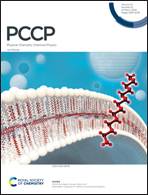Gas adsorption and light interaction mechanism in phosphorene-based field-effect transistors†
Abstract
Phosphorene-based field effect transistor (FET) structures were fabricated to study the gas- and photo-detection properties of phosphorene. The interplay between device performance and environmental conditions was probed and analyzed using in situ transport measurements. The device structures were exposed to different chemical and light environments to understand how they perform under different external stimuli. For the gas/molecule detection studies, inert (Ar), as well as, oxidizing (N2O), and reducing (H2 and also N2H4) agents were selected. The FET structure was exposed to these different gases, and the effect of each gas on the device resistance was measured. The study showed varying response towards different molecules. Specifically, no significant resistance change was observed upon exposure to Ar, while H2 and N2H4 were found to decrease the resistance and N2O had the opposite effect resulting in an increase in resistance. This work is the first demonstration for the detection of N2H2 and N2O using a phosphorene-based system. These phosphorene-based FET structures were also found to be sensitive to light exposure. When such structure was irradiated with light, the current modulation was lost. The observed resistance changes can be explained as a result of the modulation of the Schottky barrier at the phosphorene-electrical contact interface due to the adsorbed molecules and charge transfer, and/or photo-induced carrier generation. The results were consistent with the transfer characteristics of Vdsvs. Vg.



 Please wait while we load your content...
Please wait while we load your content...
